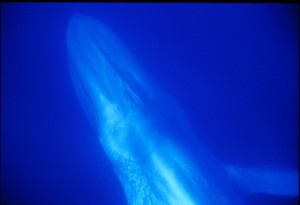Revealing Blue Whale Mysteries! (Written February 28, 2013)

The largest mammal on earth requires great attention due to the mystery surrounding their life cycle and behaviours.
Photo credit: Micheline Jenner
“Sulphur-bottom” whales, so-named for the lemon-yellow colouring on their under-bellies (actually diatoms that grow on them in rich Antarctic waters), are also known as blue whales, despite actually being grey in colour. When they dive below the surface the blue of the water is reflected into our eyes off their pale grey skin, and these intriguing animals appear to be blue!
Blue whales are the largest marine mammals, the largest mammals, and indeed are the largest living creatures.
There are three, or perhaps four, subspecies of blue whale worldwide: B. m. musculus, the northern blue whale consisting of the North Atlantic and North Pacific populations, B. m. intermedia, the southern blue whale of the Southern Ocean and Antarctica, B. m. brevicauda, the pygmy blue whale found in the Indian Ocean and South Pacific,and a questionable B. m. indica, the great Indian rorqual, which is also found in the Indian Ocean and, which may be the same subspecies as B. m. brevicauda.
Antarctic blue whales are generally considered to range south of 55 degrees latitude during the austral summer. Any blue whale observed north of 54 S, during the summer were found by whalers to be pygmy blue whales. This geographical separation is borne out by slight but definite morphological differences. Principally, pygmy blue whales have a more rounded head shape and a shorter distance between the dorsal fin and the tail, while Antarctic blue whales have a more torpedo-shaped head and their dorsal fins are set relatively further forward than that of the pygmy. Interestingly, but logically, this different body shape translates into a different swim style which is easily detected by experienced spotters.
At greater than 30 metres long, Antarctic blue whales were desirable and heavily targeted when commercial whaling operations on this species began in 1904. Gathering in summer months in the polar region to feed on krill (Euphausia superba), the largest source of protein on the planet, the great blue whale herds have been reduced to less than 1% of their original population so that today perhaps as few as 3,500 remain.
Pygmy blue whales, slightly smaller sized with a maximum length of 24 metres, had a pre-whaling population thought to be far less than that of Antarctic blues at approximately 13,000 individuals. During whaling their population was less depleted than the Antarctic blue whales but their current global population status is still unknown. However, in the Perth Canyon, Western Australia where CWR research pygmy blue whales, it is estimated the population that migrates throught the eastern Indian Ocean is around 1000 individuals.
Using differences in their song patterns, blue whale sub-species have been further characterised into nine different worldwide bioregions. Using long-term vocalisation data-bases, blue whale call structures have been shown to remain extremely stable even over four decades.
Individual calls are distinctive with high intensity (188 dB), low frequency (16-100Hz) and long duration. Whale songs are comprised of units (continuous segments of sound) and phrases (repeated combinations of units). However, blue whales do not further combine these units and phrases into repetitive themes, as humpback whales are famous for doing in their songs, but sing monotones and simple upsweeps and downsweeps.
But why do blue whales want to call across ocean basins? Conceivably, a number of social functions could be fulfilled with long range calling and counter-calling between individuals, mostly likely to be focussed around individual and/or species preservation strategies such as foraging and breeding activities. Do males use the calls to attract females? Do females call? Can the whales use low frequency calls to detect seamounts and canyons or even huge swarms of krill? Is calling a means to spread individuals across a large area that may contain localised bursts of krill, and thereby signal its position to prospective mates? So the better an individual is at locating food, and bragging about it, the more opportunities to mate it receives? Lots of questions and ideas to test…
In the Perth Canyon, Western Australia, two populations of blue whales congregate at different times of year. Antarctic blues are present in the Canyon in the austral winter (June/July), moving southward to the Antarctic ice-edge during the summer. Pygmy blue whales spend the summer (Feb-May) in the Perth Canyon and then migrate northward to the islands of Indonesia during the austral winter, travelling along the NW Australian coastline and feeding opportunistically but regularly at offshore islands and seamounts.
One of the most intriguing uses of blue whale song is its use in estimating population size. These sparsely distributed whales are extremely difficult to detect visually but if we take a page from their own book, we can detect individuals from perhaps hundreds or even thousands of kilometres away. An incredible way to count them and then target scientific studies directly at the feeding or breeding hotspots in use, in real-time. Basically we’ll be acting like blue whales ourselves! Luckily our new partnership with our Defence Department gives us the acoustic technical skills to carry this through.
Mich

No comments yet.